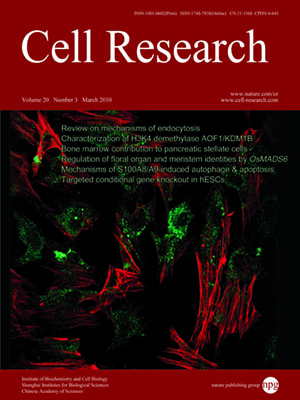
Volume 20, No 3, Mar 2010
ISSN: 1001-0602
EISSN: 1748-7838 2018
impact factor 17.848*
(Clarivate Analytics, 2019)
Volume 20 Issue 3, March 2010: 314-331
ORIGINAL ARTICLES
S100A8/A9 induces autophagy and apoptosis via ROS-mediated cross-talk between mitochondria and lysosomes that involves BNIP3
Saeid Ghavami1,2,3, Mehdi Eshragi1, Sudharsana R Ande1, Walter J Chazin4, Thomas Klonisch5, Andrew J Halayko2,3, Karol D Mcneill3, Mohammad Hashemi6, Claus Kerkhoff7 and Marek Los8
1Department of Biochemistry and Medical Genetics, Manitoba Institute of Cell Biology, CancerCare Manitoba, Winnipeg, Canada
2Department of Physiology, University of Manitoba, Winnipeg, Canada
3Manitoba Institute of Child Health, University of Manitoba, Winnipeg, Canada
4Department of Biochemistry and Chemistry, Center for Structural Biology, Vanderbilt University, Nashville, TN 37232-8725, USA
5Department of Human Anatomy and Cell Science, University of Manitoba, Winnipeg, Canada
6Department of Clinical Biochemistry, Zahedan University of Medical Sciences, Zahedan, Iran
7Institute of Immunology, University of Muenster, Roentgenstr. 21, Muenster, Germany
8Interfaculty Institute of Biochemistry, University of T黚ingen, Hoppe-Seyler-Street 4/401B, T黚ingen, Germany
Correspondence: Claus Kerkhoff, Marek Los,(kerkhoc@uni-muenster.de; marek.los@ifib.uni-tuebingen.de )
The complex formed by two members of the S100 calcium-binding protein family, S100A8/A9, exerts apoptosis-inducing activity in various cells of different origins. Here, we present evidence that the underlying molecular mechanisms involve both programmed cell death I (PCD I, apoptosis) and PCD II (autophagy)-like death. Treatment of cells with S100A8/A9 caused the increase of Beclin-1 expression as well as Atg12-Atg5 formation. S100A8/A9-induced cell death was partially inhibited by the specific PI3-kinase class III inhibitor, 3-methyladenine (3-MA), and by the vacuole H+-ATPase inhibitor, bafilomycin-A1 (Baf-A1). S100A8/A9 provoked the translocation of BNIP3, a BH3 only pro-apoptotic Bcl2 family member, to mitochondria. Consistent with this finding, ΔTM-BNIP3 overexpression partially inhibited S100A8/A9-induced cell death, decreased reactive oxygen species (ROS) generation, and partially protected against the decrease in mitochondrial transmembrane potential in S100A8/A9-treated cells. In addition, either ΔTM-BNIP3 overexpression or N-acetyl-L-cysteine co-treatment decreased lysosomal activation in cells treated with S100A8/A9. Our data indicate that S100A8/A9-promoted cell death occurs through the cross-talk of mitochondria and lysosomes via ROS and the process involves BNIP3.
Cell Research (2010) 20:314-331. doi: 10.1038/cr.2009.129; published online 24 November 2009
FULL TEXT | PDF
Browse 2589


